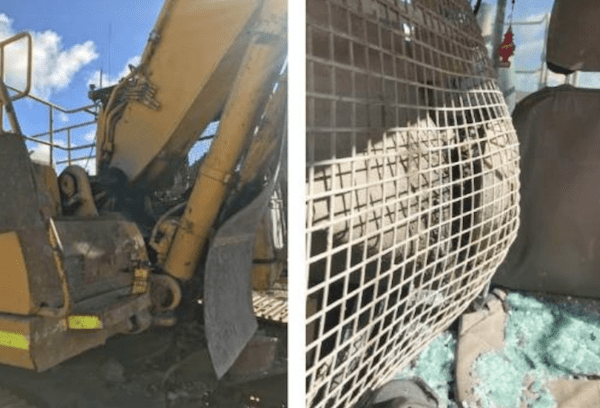The WA DMIRS has issued a warning to mines in a Mine Safety Bulletin regarding the use of excavators as rock breakers following a high potential incident in June 2018. The catastrophic failure of booms can occur for a variety of reasons and the regulator is reminding the industry of the significant risk potential associated with booms and the subsequent procedures to be implemented for reducing risks from these events.
The department said in their latest bulletin that in June 2018, a potentially serious incident involving a 45-tonne excavator fitted with a hydraulic hammer occurred at a mine site. The machine was being used to break rocks on a stockpile pad when one of the boom supports failed suddenly and catastrophically, causing the boom to slide off its support pin and break through the side window of the operator’s cab.
Metal mesh installed on the side window of the cab to protect the glass from rock damage prevented the foot of the boom from crashing further into the cab space. The operator escaped with minor cuts from the broken glass.
Summary of hazard – Booms can fail!
Excavator booms can fail suddenly and catastrophically in numerous ways. Although such events are rare, the consequences can be serious. The operator cab on an excavator is not designed to protect the operator from broken boom components hitting or crushing the cab. Typical protective devices such as rock mesh fitted to cab windows and ROPS/FOPS certified cabs are designed to protect the operator from other hazards. Although such devices may reduce the consequences of a catastrophic boom failure, they should not be relied upon for this purpose because they are not designed for this purpose.
What are the contributory factors of excavator boom failure?
Using an excavator as a rock breaker for prolonged periods acts as ‘design change’ or ‘change in use.’ Original Equipment Manufacturer (OEM) manuals may not provide adequate instruction for the use of the excavator with a rock breaker tool if it is used for a prolonged period.
Although it is accepted practice in the industry to use excavators with rock breaker tools, doing so for prolonged periods may affect the life of components due to increased cyclic loading, shock loads and vibration.
Operator practices, such as using the rock breaker attachment for raking and sweeping, may contribute to abnormal loading of the excavator boom that may affect the life of components. Repairing fatigue cracks using unapproved methods and/or unqualified repairers may not be fully effective, thereby increasing the risk of sudden catastrophic failure of boom components.
Inadequate cleaning of the excavator prior to maintenance may contribute to fatigue cracks remaining undetected, increasing the risk of sudden catastrophic failure of boom components.
Actions required by mining sites to improve excavator safety
When considering the prolonged use of an excavator with a rock breaker tool, to control the risk of sudden catastrophic failure of booms, arms and other ancillary components:
- ensure the specific rock breaker tool to be fitted is approved for use by the OEM on the particular excavator model
- any significant ‘design change’ or ‘change in use’ that is not adequately addressed in the existing OEM manuals or other OEM guidance materials, requires an appropriate risk assessment by a competent person(s)
- consult the OEM and implement any recommended changes to their routine scheduled maintenance and inspection requirements and with regard to procedures for inspecting, assessing and repairing fatigue-related cracks in components of the boom
- when crack defects are detected, the assessment and recommendation of repair methodology requires specialist knowledge and should only be undertaken by competent persons and in accordance with OEM recommendations
- ensure excavators are adequately cleaned prior to maintenance so that visual, or other forms of inspection, will be effective in finding defects
- when inspecting for cracks, give particular attention to existing welds where fatigue cracking is likely to initiate (e.g. any sharp fillet weld toes or other weld related defects)
- provide adequate training and assessment of operators regarding the safe and correct use of the excavator with a rock breaker tool.
Consult the OEM for advice on competency requirements inspect the current condition and maintenance history of secondhand, hired and itinerant equipment before use. Further information Business
References
Queensland, Mines Safety Alert No. 282 Catastrophic Structural Failure of Excavator Boom (20 January 2012) www.dnrme.qld.gov.au/business/mining/safety-and-health/alerts-and-bulletins/minessafety/catastrophic-structural-failure-of-excavator-boom
Image DMIRS L. Inboard boom ear failure. R. Damaged rock mesh and the broken window.
Read more Mining Safety News














Add Comment